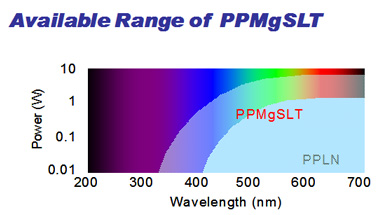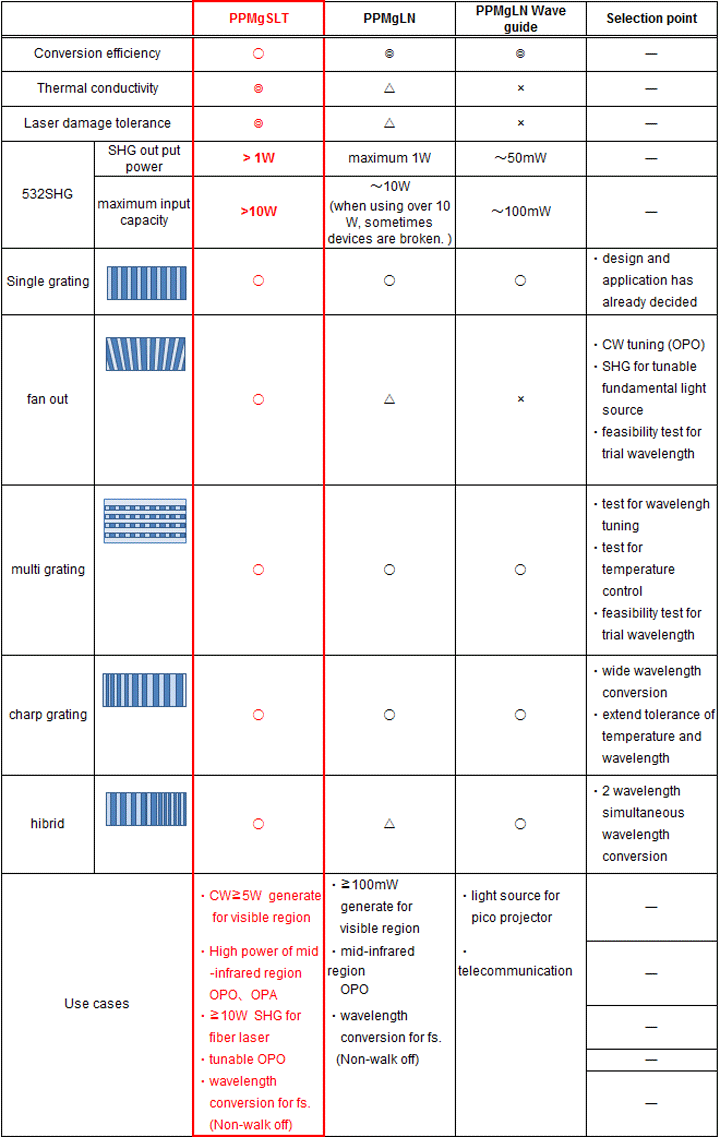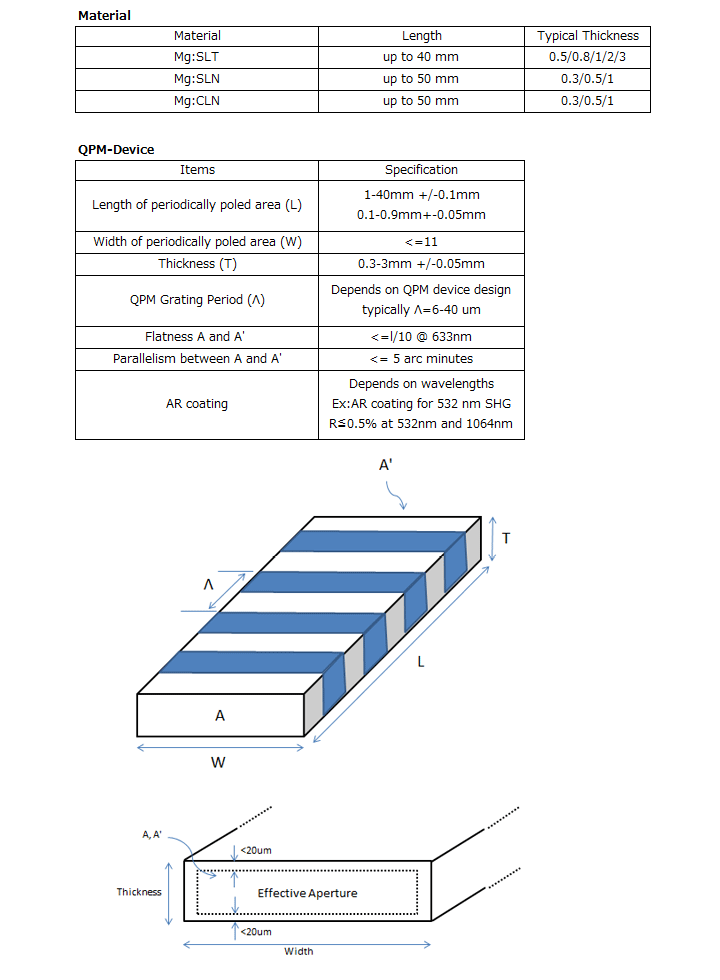Optical Devices Technology
Wafers, Devices or Modules for Wavelength-Conversion
Oxide is ready to offer the optimum solution for specific need of each customer.
Oxide manufacturing capabilities cover all the way from LN/LT crystal growth, wafering process, QPM device designing and assembling to fabrication of QPM-device-integrated modules, and all in one same place, our Yamanashi Factory. Our profound knowledge of wafer properties help us produce better QPM devices and our deep understanding of QPM devices enables us high-performance wavelength-conversion modules. With our integrated production system and wide technology background, Oxide can answer the requirements from the customers in a ever more efficient and cost effective way and at higher level.
MgSLN、MgSLT wafer
Need large-sized high-quality base material for high-efficiency QPM Device?
If you want to get reliable wavelength-conversion material at reasonable cost, MgLN or MgSLT, both high-performance materials, is the best answer. Oxide provides large-sized (3 inches) high-quality MgLN and MgSLT wafers based on its years of experience and world-leading technology in crystal growth and wafering process.
For properties comparison between different materials, please refer to the attached table.
QPM Device
Wish to generate lights of various colors?
Why not try Oxide QPM Device?
QPM device is a dream tool, which efficiently converts UV-IR range light of into high-quality beam with your desired wavelength. Oxide produces PPMgLN and PPMgLN waveguide, characterized by high conversion efficiency, as well as PPMgSLT, suitable for high power operation.
What is QPM?
QPM device is a dream tool, which efficiently converts UV-IR range light,cw-fs of into high-quality beam with your desired wavelength.(without walk off)
QPM stands for quasi-phase-matching, a technique which converts an incoming light into an output beam of desired wavelength by passing the former through a periodically poled structure created on such ferroelectric crystal material as LN or LT. By changing the design of periodically poled structure, it is possible to tune the output beam with desired wavelength. Main features of QPM devices are:
- Can convert the light into a beam with desired wavelength by changing the periodic poling design.
- Can fully utilize the high conversion efficiency characteristic of the material.
- Can emit high circular converted beam without walk-off.
What kind of QPM device to be offered?
We, OXIDE, produce 3 types of QPM products, PPMgLN, PPMgLN waveguide, and PPMgSLT. In addition, we produce QPM device mount with temperature controller, which is easy to install in your application.

We can also custom-make multi-grating, chirping, fan-out, multi-cycle, such as hybrid structures to better suit your needs. We will propose a detailed specification based on the attached sheet.

Which QPM to choose?
There are several non-linear optical devices available, but there is a rather simple rule that will help your choice.
- PPMgLN, PPMg waveguide are the right materials if higher conversion efficiency is what you need. They are suitable for emission of low output(mW)-middle output(W) beam. If the power of your light source is on low side and higher conversion efficiency is needed, PPMgLN and PPMgLN waveguide are recommended.
- PPMgSLT has the merits of high thermal conductivity and high power resistance and yet its conversion efficiency is satisfactorily high. This is the right material if you want to obtain pulse-laser or several W –20W beam. For more details, please refer to our technical brochure “QPM Selection Guide”.
- According to design the period of QPM, it is able to work against any wavelength, and any wavelength conversion methods.(SHG、SFG、DFG、OPO、OPG、OPA)
- SHG: Second harmonic generation
- SFG: Sum frequency generation
- DFG: Difference frequency generation
- OPO: Optical parametric oscillation
- OPA: Optical parametric amplification 光パラメトリック増幅
Overview of QPM devices that are offered by our company are as follows.

Handling for QPM device
■If you try to use our QPM devices, please refer to the “QPM device instruction” that summarizes the note of handling.
Reference Literature
■For more technical information, please refer to some published literature for each material.
| Material | References | ||
| Optical properties | Refractive index (Sellmeier equation) |
MgLN | D. E. Zelmon et al., J. Opt. Soc. Am. B Vol. 14, p. 3319 (1997). |
| SLT | A. Bruner et al., Opt. Lett. Vol. 28, p. 194 (2003). | ||
| MgSLT | M. Nakamura et al., Jpn. J. Appl. Phys. Vol. 41 p. L465 (2002). | ||
| Device design | d coefficient | LN/LT | I. Shoji et al., J. Opt. Soc. Am. B Vol. 14 p.2268 (1997). |
| Chirping | LN/LT | T. Suhara and H. Nishihara, IEEE J. Quant. Electro. Vol. 26, p. 1265 (1990). | |
| Apodization | LN/LT | J. Huang et al., Opt. Lett. Vol. 31, p. 604 (2006). | |
| Physical and damage related properties | Thermal conductivity | MgSLT | K. Kitamura et al., Oyo buturi 74, p.573 (2005) |
| MgSLT | N. E. Yu et al., ,Jpn. J. Appl. Phys. Vol. 43, p. L1265 (2004). | ||
| MgSLT | M. Nakamura et al., Jpn. J. Appl. Phys. Vol. 51, 012601 (2012). | ||
| Pulse damege threshold | LN/LT | N. E. Yu et al., ,Jpn. J. Appl. Phys. Vol. 43, p. L1265 (2004). | |
| GRIIRA Photorefractive damage threshold |
LN/LT | K.Kitamura et al., Ferroelectrics Vol. 257, p. 235 (2001) | |
| Application examples. | CW generation (UV to visible) |
MgSLT | T. Mochizuki et al., Advanced Solid state Photonics (ASSP) 2008 MG5 (2008). |
| MgSLT | M. Oka et al., SPIE Photonics West 2008, 6875-20. (2008) | ||
| MgSLT | G. K. Samanta et al., OSA CLEO 2010 CWQ7 (2010). | ||
| MgSLT | S. V. Tovsting et al., Opt. Express, Vol. 16, 11294 (2008) | ||
| MgSLT | M. Jacquemet et al., FILAS 2011 FThE11, (2011). | ||
| MgSLT | J. Hirohashi et al., Advance Solid state Photonics, 2012 AT4A.22 (2012). | ||
| Pulsed generation (UV to visible) |
MgSLT | N. E. Yu et al., Jpn. J. Appl. Phys. Vol. 43, p. L1265 (2004). | |
| MgSLT | J. Hirohashi et al., OSA CLEO 2010 CMG4 (2010). | ||
| MIR generation | MgSLN | M. Maruyama et al., Appl. Phys. Lett. Vol. 89, 011101 (2006 ). | |
| MgSLT | N. E. Yu et al., Appl. Phts. Lett. Vol. 85, p. 5134, (2004) | ||
■The material properties of MgSLN and MgSLT, please see also the following page.



